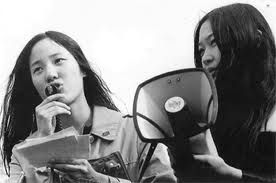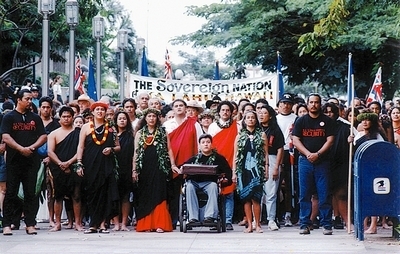
ASIAN AMERICAN & PACIFIC ISLANDER MOVEMENTS
The Asian American movement of the 1960s and '70s, like the other major civil rights/ethnic power struggles of the era, forever changed Asian American life in the US. Indeed, the category Asian America arose in that era as a political term. The radical phase of the movement included street level groups like I Wor Kuen (NY) and the Red Guard (SF), both of which drew inspiration from the Black Panthers and like the Panthers sought both community improvement and a larger political agenda of opposing US imperialism in Vietnam and elsewhere. The Bay Area movement also included major student groups like the Asian American Political Alliance at UC Berkeley and San Francisco State that sought to unite the various Asian ethnicities. They played a major role in the creation of the field of Asian American studies that radically reshaped the story of Asian American life.

 .
.
Left: Photo copyright © by Nikki Arai. International Women's Day rally in San Francisco's Chinatown in 1971. Right: copyright unknown. Hawaiian sovereignty movement protest;
The movement included a number of human rights issues, including most dramatically pushing through recognition of the injustice of the internment of Japanese Americans during World War II. In the face of the stereotype of Asians as the "model minority," the movement raised a host of issues about economic and social injustice towards many ethnic Asian populations.
The movement also made important cross-racial and international alliances with figures in Asia and Third World countries around the globe. As with the other major struggles of the 1960s, the movement became less visible and often less confrontational in later decades, but a wide range of community-based organizations have continued to fight for the rights of various groups collectively termed Asian American in a US context. New waves of Asian immigrants (the second largest immigrant bloc after Latinos in recent years) also have brought forth new exploitation and discrimination, and therefore new waves of activism.
Hawaiians and Pacific Island peoples had both overlapping and differing concerns than mainland Asian Americans. This includes a long-standing Hawaiian sovereignty movement. Pacific island peoples also long protested nuclear testing in their region, and are now working against the climate change that is threatening to submerge many communities in the Pacific.
Some Key Historical & Contemporary Activist Organizations/Issues
- 350 Pacific. Grassroots, youth-led climate justice movement by Pacific Islanders
- 'Āina Momoma. Hawaiian sovereignty through environmental & social justice.
- APWLD Feminist movement for climate justice in the Asian Pacific.
- Asian American Political Alliance. UC Berkeley and SF State-based student radicals who sought to unite all Asian ethnicities into a common movement in 60s/70s.
- Asian American Activism. Web audiocast of 60s/70s activists panel based on Steve Louie's book, Asian Americans: The Movement and the Moment.
- Asian Americans Advancing Justice.
- Asian Americans for Equality.
- Asian American Movement. Bills itself as "radical Asian American perspectives."
- Asian American Movement. Daryl Maeda Oxford Research Encyclopedia essay.
- Asian American Movement in the Bay Area, 1968-1974.
- Asian Americans United.
- Asian Left Forum.
- Asian Pacific Americans Labor Alliance.
- Asian Task Force Against Domestic Violence.
- CAAAV: Organizing Asian Communities. New York City.
- Congressional Asian Pacific American Congressional Institute.
- Filipino American Activism Across Three Generations.
- Filipino American Coalition for Environmental Solidarity.
- Forgotten Zine of 1960s Asian American Radicals. Story of Gidra magazine.
- Gabriela Network. Philippine-U.S. Women's Solidarity Organization.
- Hawai'i - Independent and Sovereign.
- Hawaiian Sovereignty Movement. Basic article from wikipedia.
- History of the Asian American Civil Rights Movement. Essay by Nadra Kareem Nittle.
- Ho'Okua'Aina. Hawaiian rebirth the land movement.
- Hmong Homepage.
- I Wor Kuen. NY-Chinatown-based 60s/70s radicals modeled on Black Panthers.
- Japanese American Citizens' League.
- Japanese American Network.
- Khmer Girls in Action.
- Korean Resource Center.
- National Congress of Vietnamese Americans.
- National Korean American Service and Education Consortium.
- Organization of Chinese Americans.
- Pacific Islander Cultural Association.
- Pacific Islander Poetry and Culture.
- Red Guard Party. SF Chinatown-based 60s/70s radicals.
- Seattle's Asian American Movement. Web essay from U Washington Civil Rights Consortium.
- Southeast Asian Resource Action Center.
- South Asian Women's NETwork.
- Stanford Asian American Activism Committee.
- Additional Links to Asian American Community/Political Organizations.
Cultural Resources: Literature, Music and Visual Culture
- AAMP!itude. Asian/Asian American Music Reviews.
- Advertisements from the Spanish-American and Philippine-American Wars.
- Journal of Asian American Art and Literature.
- Angry Asian Man. Seriously funny commentary on anti-Asian racism.
- Asian American Studies Program Video List. University of Wisconsin, Madison.
- Asian American Writers' Workshop.
- Asian, Pacific, and South Asian Video University of California, Berkeley.
- Deep Focus Productions. The website for Arthur Dong, documentary director.
- Filipinos at World's Fairs and Expositions.
- Foundation for Asian American Independent Media
- Images of War and Empire. Including Philippine-American War.
- Media Action Network for Asian Americans (MANAA).
- MANAA Video Guide.
- Motion Picture Goes to War: The Spanish American War and The Philippine Revolution American Memory Project, Library of Congress.
- NAAATA Film and Video Catalog.
- CAAMFestThe Center for Asian American Media Festival, Formerly International San Francisco Asian American Film Festival
- Neely's Photograph: Fighting in the Philippines.
- San Diego Asian Film Festival.
- SEAAdoc. An educational resource of the Southeast Asian Archive at the UC Irvine Libraries focusing on post-1975 refugees and immigrants from Cambodia, Laos, and Vietnam and the communities they have developed in the United States.
- "Suffering Under a Great Injustice: Ansel Adams Photographs of Japanse-American Internment at Manzanar.
- Yellow Rage. Political spoken word performance.
Selected Books and Articles on the Movement
- Espiritu, Yen. Asian American Pan-Ethncity. Philadelphia: Temple U Press, 1993. Sophisticated study of the difficulties and successes of organizing across various Asian identities in the US.
- Fujino, Diane. Samurai Among Panthers: Richard Aoki on Race, Resistance and a Paradoxical Life. Minneapolis: University of Minnesota Press, 2012.
- Habal, Estella. San Francisco’s International Hotel: Mobilizing the Filipino American Community in the Anti-Eviction Movement. Philadelphia: Temple University Press, 2007. One of the key movement issues of the 60s/70s era.
- Ho, Fred, et al. eds. Legacy to Liberation: Politics and Culture of Revolutionary Asian/Pacific America. San Francisco: AK Press, 2001. Rich anthology of movement documents.
- Ishizuka, Karen L. Serve the People: Making Asian America in the Long Sixties. New York: Verso Books, 2016. Definitive history based on hundreds of interviews with activists. "Making and Unmaking of the Asian American Movement." Michelle Chen essay and interview with Ishizuka.
- Michael Liu, Kim Geron, and Tracy Lai.The Snake Dance of Asian American Activism: Community, Vision, and Power. Lanham, MD: Lexington Books. 2008. Traces movement from 1930s to 1990s to historicize and contextualize ongoing activism.
- Louie, Steve, ed. Asian Americans: The Movement and the Moment. LA: UCLA Asian American Studies Center Press, 2001. Collection of important cultural and political texts from the movement.
- Lowe, Lisa. Immigrant Acts: On Asian American Cultural Politics. Durham NC: Duke U Press, 1996. Brilliant long-range view of the making of Asian Americans.
- Maeda, Daryl. Chains of Babylon The Rise of Asian America. Minneapolis: U Minnesota, Press, 2009. Innovative book on the Asian American movements.
- Maeda, Daryl. Rethinking the Asian American Movement. New York: Routledge, 2012.
- Pulido, Laura. Black, Brown, Yellow, and Left: Radical Activism in Los Angeles. Berkeley: U California Press, 2006. Includes much on Asian American activism and coalition building with other ethno-racialized Americans.
- Trask, Haunani-Kay, dir Act of War: The Overthrow of the Hawaiian Nation (1993). Documentary film on the continuing fight for Hawaiian sovereignty.
- ___, From a Native Daughter : Colonialism and Sovereignty in Hawaii. Honolulu: University of Hawaiʻi Press, 1999.
- Umemoto,Karen. “‘On Strike!’ San Francisco State College Strike, 1968–69: The Role of Asian American Students,” Amerasia Journal 15.1 (1989): 3–41. Key late 60s movement that helped birth Asian American studies.
- Vo, Linda Trinh. Mobilizing an Asian American Community. Philadelphia: Temple U Press, 2004. Excellent, sophisticated but accessible study of interethnic Asian American organizing.
- Wei, William. The Asian American Movement. Philadelphia: Temple U Press, 1993. Interpretively weak, but with some useful history.
- Wu, Judy Tzu-Chun. Radicals on the Road: Third World Internationalism and American Orientalism during the Vietnam Era. Ithaca, NY: Cornell University Press, 2013.
- Yamashita, Karen Tei. I Hotel. San Francisco: Coffee House Press, 2010. Novel is a profound evocation of the Asian American movement in San Francisco Bay Area and its relation to the whole range of progressive social movements of the 1960s and 70s. It captures both the lived experiences and ideological complexity of the era. Best approached after reading some of the relevant history books for context.
- "Yellow Power: Origins of the Asian America." article from Densho blog.
Research Institutes, Programs, and Libraries
- Asian American Center for Advancing Justice.
- Asian American Studies. University of California, Irvine.
- Asian American Studies Center. University of California, LA.
- Asian American Studies Program. Cornell University, Ithaca, NY.
- Asian and Pacific Islander American Health Forum.
- Asian/Pacific/American Studies Program and Institute. New York University.
- Asian-Nation. Major resource site for AA demographic & other information.
- Association for Asian American Studies.
- Chinese Historical Society of Southern California .
- Chinese Historical Society. San Francisco.
- Chinese American Museum.
- Kawaiheulani Center for Hawaiian Studies.
